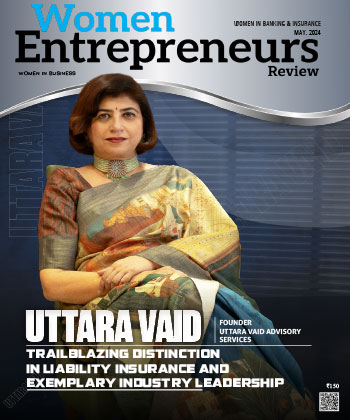
"Empowering the Workforce: A Chief People Officer's Perspective
By: Pia Shome, Chief People’s Officer, U GRO Capital
Pia Shome is the Chief People’s Officer at U GRO Capital and is the primary interface between the company’s prospective employees and the U GROites. She brings in 19+ years of broad exposure in Human Resources, Change Management, Organization Transformation and Culture Building. She is a comprehensive leader with all-encompassing experience. Before joining U GRO Capital, she cut her teeth in this industry by attaining and executing leadership positions in many renowned organisations.
In conversation with Women Entrepreneur India magazine, Pia shares her view about how diversity and inclusivity matter for organizational success and also shared about the methods for preserving employee well-being and mental health
How do you facilitate a positive work environment and how do you plan on attracting and retaining talent in a highly competitive field?
As the Chief People Officer of a data-tech NBFC, I understand the significance of fostering a positive work environment and attracting/retaining talent in a highly competitive field. When it comes to facilitating a positive work environment, there is truly nothing better than putting the onus on the employee. One of the most prominent ways to create engagement amongst employees and build a healthy workplace culture is to bring together all engagement and people initiatives – celebrations, workshops, talent hunts, sports, policies, etc. under one umbrella employee care program that sets the tone for the organisation. For instance, a sports tournament always fires up the company spirit and sees overwhelming participation. During any corporate tournament, employees are often seen to go beyond work hours to practice, and the lines of office designations and ranks begin to disappear; even those not physically on the field are seen revelling in the competitive spirit in support of their work friends.
To attract and retain talent, it is important to develop and communicate a strong employer brand that highlights the company's mission, values, and unique attributes. Faster and smoother recruitment processes, offers of competitive compensations and benefits, and remaining committed to employee engagement are the ways that I try to actively help build a healthy workplace.
Why does diversity and inclusivity matter for organizational success? What are the best tools to help organizations with diversity and inclusion? What is the role of leadership in achieving diversity and inclusion?
A diverse workforce brings together individuals with unique perspectives, backgrounds, and experiences. This diversity of thought and approach sparks creativity, fosters innovation, and enables organizations to develop ground-breaking solutions to complex problems. Indeed, inclusive organizations encourage open dialogue, collaboration, and the integration of diverse perspectives into decision-making processes. This ultimately leads to better decision outcomes and mitigates the risks of groupthink. Inclusive environments foster a sense of belonging and psychological safety, where all employees feel valued and respected. This leads to higher levels of employee engagement, satisfaction, and productivity.
To support organizations in their diversity and inclusion efforts, several tools can be utilized to be more diverse and inclusive as an organisation — providing comprehensive training programs that raise awareness, implementing more unbiased tools (data analytics and algorithms) for performance reviews and recruitment, leveraging platforms that facilitate access to a diverse candidate pool, etc.
The leadership plays a critical role in achieving this. They should lead by example, and in order to do that, must set the tone, structure inclusive policies and hold others and themselves accountable for promoting diversity and inclusion.
What are some innovative ways employers train and up skill their employees in complex and constantly evolving topics? What strategies have you used to keep employees engaged and motivated?
One of the best ways to this is to adopt micro learning techniques, breaking down complex topics into bite-sized modules. In a time when Instagram Reels and YouTube Shorts are famous, short and focused learning modules can be accessed anytime and anywhere in their short-video formats, allowing employees to learn at their own pace.
The process of gamification incorporates game elements, such as challenges, rewards, and leader boards, into the learning process. This approach makes training more interactive, engaging, and enjoyable, driving higher participation and knowledge retention.
Keeping up with the evolving times, something that organisations can look into is to incorporate Virtual Reality (VR) and Augmented Reality (AR)technologies to provide immersive learning experiences, particularly in technical or hands-on fields.
Recognizing and rewarding employees for their achievements and contributions is also crucial. This can include formal recognition programs, spot awards, or a simple appreciation for a job well done. Rewards can be both monetary and non-monetary, tailored to individuals' preferences.
As part of my experience in the industry, it goes a long way when an organisation delves deep into employee engagement initiatives. Team-building activities, sports tournaments, social events, and employee engagement programs to foster a positive work environment and strengthen relationships among colleagues.
What are the methods for preserving employee well-being and mental health, and how crucial is it to the company, in your opinion?
Preserving employee well-being and mental health not only contributes to the overall happiness and satisfaction of employees but also has significant benefits for the company itself. This comes in broadly two ways: firstly, creating a positive and inclusive work culture where employees feel valued, respected, and supported is essential; and secondly, establishing work-life balance by promoting flexible and shorter working hours, offering remote work options, and setting clear boundaries between work and personal life.
It is also important to offer access to mental health resources, such as counselling services or employee assistance programs. Educating employees about mental health issues, signs of stress, and healthy coping mechanisms are steps in the right direction.
Since physical and mental health go hand-in-hand, promoting physical well-being through regular exercise, healthy eating, and providing access to wellness programs or gym memberships go a long way.
In my opinion, taking care of employees' mental health is not only a moral obligation but also a strategic investment in the long-term success and sustainability of the organization.
What challenges did you have to overcome at the beginning of your journey? How do you define success and how long did it take you to find it?
Coming to Mumbai from almost any another city is always daunting because the scale of everything suddenly becomes manifold. My personal struggle lay in finding out how to navigate this big city and its big people as a seemingly small HR Manager. With this, a lot of the challenges were often internal — learning how to communicate with this new world that I had suddenly found myself in was the true challenge.
But my success mantra has always been and continues to be ‘resilience and persistence, with a constant wish to learn’. I don’t view success as a goal but a journey. I am considered successful today only because last year existed when I was not where I am today. It’s a trajectory that you set for your life, one that you are content with, and you continue to strive along that. It doesn’t matter if you move an inch or a mile — the key is to keep going.






